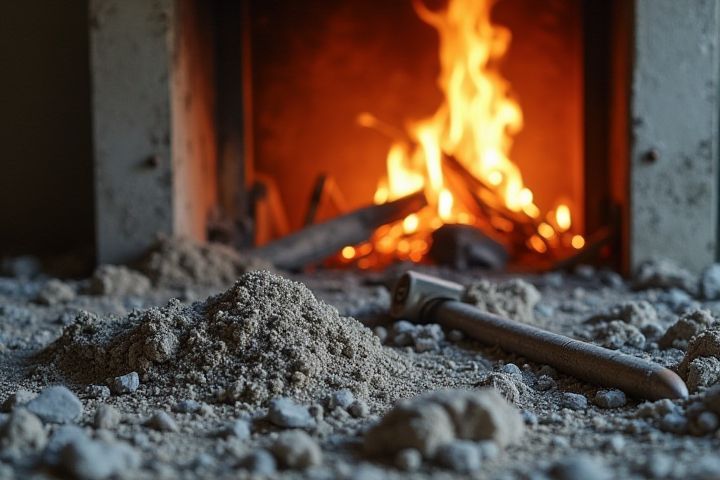
Begin by assessing the damage and ensuring the area is safe before entering. Wear protective gear such as gloves, masks, and goggles to avoid inhaling toxic substances or allergens. Remove all charred materials, including burned furniture, carpets, and any affected wiring, disposing of them properly. Use a combination of specialized cleaning agents designed for smoke and soot removal, focusing on walls, ceilings, and surfaces to eliminate persistent odors. Finally, consider hiring professional restoration services that specialize in fire damage for thorough cleaning and repair to restore your home effectively.
How To Clean A House After A Fire
Assess structural damage.
Assessing structural damage after a fire is crucial for ensuring safety and effective cleanup. Begin by inspecting the foundation for cracks and checking load-bearing walls for any signs of weakness or warping. Look for damage in the roof, especially if there are sagging areas or exposed beams, as this can indicate compromised integrity. Always consult with a professional structural engineer if you suspect significant damage, and remember that your safety should be the top priority during this evaluation process.
Wear protective gear.
Wearing protective gear is essential when cleaning a house after a fire, as it safeguards you from hazardous materials like soot and toxic fumes. Opt for high-quality respirators to filter harmful particles, gloves to protect your skin, and sturdy work boots to shield your feet from sharp debris. An overall suit can prevent ash and contaminants from contacting your clothing. Remember, prioritizing safety not only ensures your well-being but also enhances the effectiveness of the cleaning process.
Ventilate the area.
Ventilating the area after a fire is crucial for removing hazardous smoke odors and harmful particles. Open windows and doors as soon as it's safe to do so, allowing fresh air to circulate through affected rooms. Utilize fans to enhance airflow, directing them towards open exits to push contaminated air outside. Maintain proper ventilation for several hours or until you can confirm that the air quality has significantly improved, ensuring a safer environment for your recovery efforts.
Remove debris and soot.
Begin by wearing protective gear, such as gloves and masks, to ensure safety while cleaning fire damage. Use a heavy-duty vacuum cleaner equipped with a HEPA filter to effectively remove soot particles from surfaces, carpets, and upholstery, mitigating respiratory risks. For hard surfaces, a mixture of mild detergent and water can help scrub away soot, while a damp cloth is useful for wiping down walls and furniture to prevent smearing. Dispose of all debris, including damaged materials, in sealed bags to prevent the spread of hazardous particles and consider contacting professionals for extensive damage.
Clean surfaces with appropriate cleaners.
To effectively clean surfaces after a fire, start by assessing the type of materials affected, as different surfaces may require specific cleaning agents. For non-porous surfaces like countertops or metal fixtures, using a mixture of warm water and a mild detergent can effectively remove soot and residues. For porous materials, such as wood or drywall, employ specialized smoke and soot cleaners that penetrate and lift debris without causing additional damage. Ensure that you wear protective gear, including gloves and masks, to safeguard against harmful particles while cleaning.
Deodorize the space.
Deodorizing a house after a fire involves several key steps to eliminate smoke odors effectively. First, ventilate the space by opening windows and using fans to circulate fresh air, which can significantly reduce lingering smells. Then, utilize odor-neutralizing products such as activated charcoal, ozone generators, or baking soda, placing them strategically in different rooms to absorb smoke odors over several days. Finally, consider deep-cleaning upholstery, carpets, and walls, as these surfaces often retain smoke particles; steam cleaning and using specialized cleaning solutions can enhance the deodorization process.
Check electrical systems and appliances.
Check electrical systems and appliances thoroughly after a fire to ensure safety and functionality. Inspect all wiring, outlets, and circuit breakers for damage or signs of overheating, as compromised systems can pose serious hazards. Remove or replace any charred or melted components, and do not attempt to reconnect power until a licensed electrician has assessed the integrity of the system. Additionally, evaluate appliances, including refrigerators and washing machines, for irreparable damage, replacing any that are not functioning properly or show fire-related harm.
Dispose of unsalvageable items.
After a fire, prioritize the disposal of unsalvageable items to ensure a safe and thorough cleaning process. Start by assessing all personal belongings, including furniture, clothing, and appliances; items with excessive smoke or water damage should be discarded. Properly dispose of hazardous materials, such as burnt electronics or chemical containers, following local regulations to mitigate health risks. Document the damaged items for insurance claims, as you might need to provide evidence of loss for reimbursement or future restoration efforts.
Restore and repaint walls and ceilings.
Restoring and repainting walls and ceilings after a fire requires careful preparation and methodical execution. Begin by removing soot and smoke damage using a mixture of warm water and a specialized cleaning solution, ensuring safety with protective gear like gloves and masks. Once cleaned, inspect for any structural damage, and apply a high-quality primer designed for smoke damage before selecting a flame-retardant paint for the final coat. This will not only enhance the appearance of your space but also provide an added layer of protection against future incidents.
Consult professionals for extensive damage.
Consulting professionals for extensive damage after a fire is crucial for safe and effective cleanup. Experienced fire restoration companies use specialized equipment and techniques, such as industrial-strength vacuums and air scrubbing systems, to remove soot and smoke residue. These experts can assess structural integrity, identify hazardous materials, and handle toxic chemicals that may linger post-incident. Engaging professionals not only ensures thorough cleaning but also helps restore your home to a safe and livable condition.
